Do you find that most ready to wear tailored jackets need lots of alterations just to look okay? Maybe you’ve got a large drop, long arms or wide shoulders. If so, the made to measure jackets and suits from Proper Cloth just might be the answer to your problems. Read on for my take of this #menswear stalwart’s new tailored clothing line.
Proper Cloth has been a mainstay of the custom shirt world for over a decade. Started in 2008 by Seph Skerritt while he was in business school, they’ve grown to be a major online retailer. Just about every guy I know has a Proper Cloth shirt. I’ve been a customer for about four years, and some of my most-worn shirts were made by them.
As they’ve grown, they’ve expanded beyond shirts into knitwear, accessories, ties and more, but their latest addition is made-to-measure tailoring.
I reached out to Seph to find out if they had a sample jacket lying around that I could handle, try on and photograph, but alas they did not. Instead, he had senior designer Chris Callis get me set up with a made to measure jacket. I presumed that once I was finished with it, I’d return it to them to put on a mannequin in their showroom. But when I called up Chris to conduct an interview, he told me it was mine to keep. That was a nice surprise, and I’m grateful to them for their generosity. (My policy on free products and my relationship with brands can be found here). That hasn’t colored my opinions, however, so read on to find out my thoughts.
The Appeal
What caught my eye about PC’s tailored jackets, specifically as an heir to the Eidos mantle in my mind, was the aesthetic. Specifically, the shape of the lapel. They’ve got that beautiful, slightly concave arc that starts at the notch, swooping down into the buttoning point, then inflecting to curve gently away below the button into the front quarters. Nobody does that, except Eidos under Ciongoli (and now, Spier & Mackay in their Neapolitan cut). And indeed, that was one of PC’s reference points when developing their own product. “While we were considering a lot of things, Eidos was certainly part of the conversation, because they struck a really nice balance of offering a particular look with beautiful lines and shapes, but in a subtle way that was accessible for the guy who just wants a more familiar product that he knows will work in the office,” Chris told me.
The rest of the design details are familiar and welcome—a soft, natural shoulder (though not unstructured entirely), open hip patch pockets, an Italian-inspired barchetta breast pocket. But, a full-on Neapolitan garment, this is not. “We wanted to take the great shapes and lines of a Neapolitan garment, and bring it closer to a day to day garment for a younger, maybe business-oriented guy who wants something that will feel timeless and not overly stylized,” Chris says. “Maybe somewhere down the line, you’d be able to choose a pleated shoulder, but in the early stages we felt that wasn’t right for the wearability of the garment.”
The jackets are half-canvas, not full-canvas like Eidos. But the workmanship coming out of their factory in Thailand is very clean. The jacket I got is lined only in the sleeves and in the upper shoulder, exposing a lot of seams. They’re all meticulously finished. “Right now we’re doing half canvas, with a lot of handwork on top of a primarily machine-made piece. So the sleevehead is set by hand, there’s a lot of handwork done on the collar and a lot of handwork done in the vents to get everything exactly as we want it. We are not hand padding lapels or hand constructing canvassing pieces. But what we set out to say is, we’re trying to make the best value custom suit for this $600-1000 price point,” he says.
True to their reputation, the ordering process is very simple—you can answer a questionnaire that makes educated guesses based on your answers to develop a custom size, or you can type in measurements yourself, based on garments you like the fit of already. Not every aspect is changeable (for instance, you can’t change the buttoning point, or add a pleated shoulder, or make it single-vented, nor can you change details like how many buttons on the front), but what is available for customization will get most people close enough. That may change in the future as they get more feedback from their customers, however. “One of the conversations we have the most around here is ‘how much choice is the right amount of choice?’ We think we’ve arrived at a place we like on the shirting side, where people have a lot of options to choose from, but it’s not at a point where people are overwhelmed with options. And I would expect it will go that way with tailored clothing. But we’ll just have to listen to our guys and see how they go with it. It’s a conversation we have every day,” Chris says.
My specific experience in ordering this jacket was different because we did it before they had launched the made to measure website. Instead, Chris sent me a sample 42L jacket to try on, which I photographed and sent him. Based on the images and my feedback, he came up with measurements that I agreed to, and he submitted the order.
My Jacket Results
My overall impression is positive, but there are two things that hold it back from being amazing. For a normal customer in a real-world scenario, Proper Cloth will give you $75 to compensate for any alterations you may need to make with an alterations tailor. And if the problems aren’t fixable by a tailor, they will remake your first jacket completely. Since my jacket was complimentary, a complete remake is understandably not an option (though Chris did offer to send me reimbursement should I take it in for alterations). First, I feel that the shoulders are too narrow. And second, the buttoning point is 1/4″-1/2″ too high, throwing off the proportions of the jacket. Both aren’t fixable, and would require a remake (though, I do plan to ask my tailor if there’s any way to ease out the shoulders a bit somehow through magic). So, let me get into the weeds a bit to explain the two problems, and hopefully my experience here will be beneficial to you if you are thinking of buying a jacket from PC. If that sounds boring, skip the next two paragraphs.
The shoulder problem is that it buckles and sort of lifts off my shoulder at the sleeve head. I feel that additional width in the shoulder would help this problem (though it might not fix it entirely—I have a feeling perhaps I need a wider sleeve head, and that part of the problem might be my shoulders slope a bit more than the jacket is designed to accommodate. If my tailor has further insight into what’s causing it, I’ll update the post with his input). I could have avoided the narrower-than-ideal shoulder issue simply by paying closer attention when Chris and I went back and forth on the measurements. When measuring shoulder width, you always measure where the shoulder seam meets the sleeve. On all of my Eidos jackets (and indeed many other Italian-made brands), that seam starts at the collar and angles back over the shoulder to meet the sleeve slightly behind the top of your shoulder. But on Proper Cloth’s, that seam runs along the bias of your shoulder, meeting the sleeve at the very top of the sleeve head. The difference is subtle but consequential: a point to point measurement at the very top of the sleeve head will be the absolute widest point of the shoulders, but if that seam is down a bit from the top, it’ll be narrower by up to half an inch. Had I paid attention to the way the seam ran on the sample jacket he sent, I could have specified another quarter inch or more in width to match my best fitting Eidos jackets. So, my advice is: make sure and review carefully their instructions on how to measure your garment if you’re typing in your own measurements, and do it exactly the same way.
As for the buttoning point, the issue there isn’t something I could have foreseen, is likely just a personal preference of mine, and is something I think has to do with the length I specified. When entering the measurements, I had Chris enter the ideal jacket length that I wish every jacket I owned had. Why not? This is MTM after all, and that’s the point. That measurement was about 3/4” longer than the size their algorithm spit out for me, which is the length of their 42R (if you look at the numbered made-to-order sizes that are also available for you to buy). The result is a jacket that’s the right length in back, but with a buttoning point that feels a bit high, and it causes the jacket to emphasize my hips, making it feel bottom-heavy. Ideally, if they could, I’d have them lower the button by 1/2” or 3/4”. Or if not, I’d simply shorten the jacket by that much, which would still work on my frame, but would fix the proportion issues.
Since I can’t change either of these two big problems, I’m going to take the jacket to the best tailor I know—Tom Licata at Hyde Park Tailors in Cincinnati—and see if there’s anything he can do on the shoulders to ease them up a bit, and also perhaps to have him ease out the waist on the jacket to help visually lessen the bottom-heavy feel.
So those are the problems, and are things that a normal customer would have options to fix. Everything else, I’m a fan of. It’s a lightweight base canvas, with minimal additional structure in the shoulder, and a natural sleevehead. “We have essentially a suit model and a sport coat model […] It’s a two-button, notch lapel. The two models are exactly the same, but the sport coat has patch pockets, the suit has flap pockets, and some of the components inside are different: We’re using a different sleeve head and different shoulder pad on the suit; for the sport coat we use a very light sleeve head and no shoulder padding on that.”
The fabric is a beautiful 90/10 wool/cashmere from E.Thomas in a superb charcoal Prince of Wales check. “We’re very proud of the fabric mills that we work with. Where you see our taste come out [is] in the fabric selection.” And I’d have to agree, their choice of fabric, at least for this initial collection, are all tasteful and appealing. Nothing too out-there or wild, but not plain or boring in the least. I’ll be interested to see what they roll out for Spring/Summer. This particular cloth is at the highest price point in their sport coat range at $800.
What I love about Proper Cloth’s tailoring offerings that makes it a worthy successor to Eidos: That lapel shape; the generally soft construction and other Italian-inspired details; their excellent customer service and one-remake policy; and their good taste in choosing nice fabrics.
I conducted an interview with Chris Callis, which I’ve transcribed and reproduced (edited for length and clarity) below.
A huge thank you to Seph, Chris and the team at Proper Cloth for sending me a jacket—that they generously let me keep—and taking the time to answer my questions!
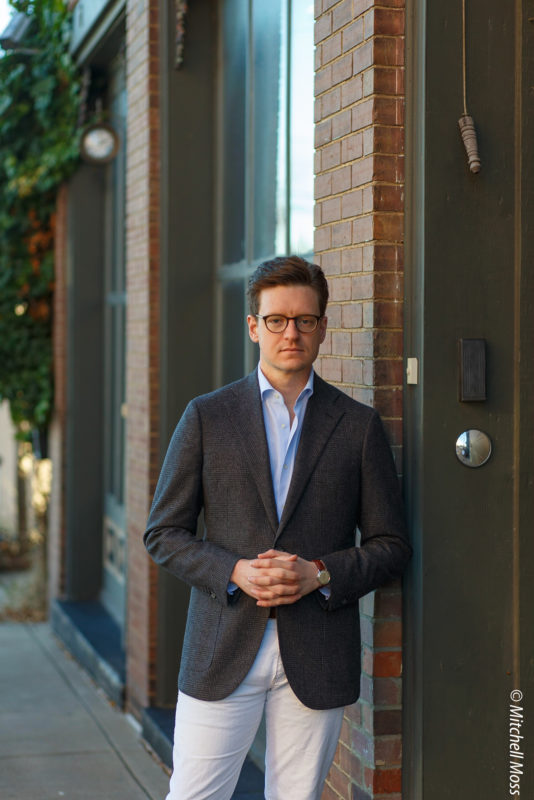
Interview With Senior Designer Chris Callis
Menswear Musings: What is your raison d’être?
Chis Callis: We’ve felt like custom clothes have been around for a long time, and with the rise of e-commerce, it’s just a no-brainer to us that it should become more accessible to people. But over the years, it’s become arguably less accessible to people, as production has gotten more industrialized, tailors have been harder and harder to come by, and the price point has risen. But now we recognize this opportunity to take custom, bring it to scale and combine it with a lot of things that get us and customers really excited. For us, what it comes down is making an incredible-value product, fully custom and easily accessible for any guy out there—no matter whether he lives in New York City and is surrounded by shops, or whether he lives out in rural Pennsylvania and doesn’t have any other options. We want to make it accessible for people to get as great of quality custom clothes as they can.
For us, you put in the little extra effort up front to get your fit totally dialed in, but then after that you can kind of buy clothes the way you would buy them on Mr. Porter, but they’re going to show up in a couple weeks and it’ll be in your custom size.
Everything we’ve built up with shirts we’ve tried to transition into tailored clothing now, with the same values and the same product quality.
MM: Who do you think of as your customer and how do you meet his needs and wants?
CC: It’s always a kind of funky question because you have your “core customer”—probably the majority of our customers are guys that work in business, and they have certain expectations. We go above and beyond on the customer service side, training side, and product side to do that—but we try not to spend too much energy saying “here’s our target customer; this is our guy; we need to build everything around this one specific guy.” We like to think of it as a brand that can service a pretty wide range of guys. In the early stages it was much more focused on dress shirts, because that’s what the sort of guy [who] really wanted custom shirts and who wanted to try us out [wanted].
But now that we’ve built a really great product and really awesome supply chain, we’ve been able to do a lot more with casual shirts—it’s brought on a whole new group of guys who don’t find a white dress shirt appealing to their lifestyle at all. And that’s a guy who wants a really great custom garment-washed indigo shirt, and he can be a different guy than the one who wears a French-cuff dress shirt day in day out.
The one thing that cuts across all those guys is the customer service element—not so aggressively saying “this is the way your garment should fit,” but instead it’s saying, “how are you going to wear this? What are your expectations? What do you think is a great fit in your head?” And training our whole team to understand how to interpret what those guys are saying, getting them to get where they want to go, and not so strongly pushing them where we want to go. If there’s a guy who says, “I trust you guys,” we’re totally happy handling that. But having really excellent customer service is willing to listen to guys and move with them instead of forcing them in a direction they may not be comfortable with.
We’re in a learning stage on the tailored product right now. We feel really good in the way things are going and the product that we have, but we’ve learned over the years to listen to our customer as much as possible because whatever preconceived notions we might have about product, or the way one guy wants it versus another, you find out that you can’t get any better information out there about what a great product is more so than actually listening to your customers. So in these early stages we’ve been pretty open-minded with things—if somebody wants to push the fit in one way or the styling, we try to be as open-minded as we can. Sure we have our personal preferences with the way we like things to look and fit, and the styling of the garment, but we try not to force people into what we like in particular.
From a garment styling perspective, right now we have a couple of models—all the sport coats come with patch pockets, it’s all a two-button notch lapel right now. But we definitely see that opening up in 2019 and beyond to service a wider range of guys’ [preferences]. We’re still having the conversations about that: “If we add a 3-2 roll jacket, do we want to take a stand on the way we want that garment to look? Should it have side vents and only side vents because that’s our look? Or do we try to build out options here so that the guy who wants a vintage Ivy look can piece that together for himself?”
MM: That’s a good point because it could get really complicated.
CC: One of the conversations we have the most around here is “how much choice is the right amount of choice?” With shirts, we have a lot of different styling options—28 collars, 12 cuffs, a bunch of front options a bunch of buttons. If you go to Ascot Chang, you can fully build out a bespoke collar for you, you can do all these adjustments to it. We think we’ve arrived at a place we like on the shirting side where people have a lot of options to choose from, but it’s not at a point where people are overwhelmed with options. And I would expect it will go that way with tailored clothing. But we’ll just have to listen to our guys and see how they go with it. It’s a conversation we have every day.
MM: How would you describe your current tailoring styles?
CC: We have essentially a suit model and a sport coat model, and they’re very similar. It’s a two-button, notch lapel. The two models are exactly the same, but the sport coat has patch pockets, the suit has flap pockets, and some of the components inside are different: We’re using a different sleeve head and different shoulder pad on the suit; for the sport coat we use a very light sleeve head and no shoulder padding on that. The base canvas is the same on them. And we just added a one-button peak lapel model for formalwear—a basic full tuxedo and some dinner jackets in that model. We tried to start with something that is really accessible for our customer, asking ourselves what’s the product that’s going to get the most people excited, knowing full well in the future we’re going to open up those options and build stuff out, offering more variety. Having the model we have will allow us to get a ton of great feedback, sell as many jackets as we want to sell, and still be something that is still an exciting to us from our own personal taste.
Your reference on Eidos is pretty spot-on. While we were considering a lot of things, Eidos was certainly part of the conversation there because they struck a really nice balance of offering a particular look with beautiful lines and shapes, but in a subtle way that was accessible for the guy who maybe just wants a more familiar product that he knows will work in the office. Our goal was to make something with elegant lines that got us excited in a comfortable zone for people, and we’re always sampling out small iterations on the current lapel shape. But we’re very happy with the way things are.
MM: Neapolitan is the current style that’s become ubiquitous—so would you say that’s the inspiration for your styling?
CC: To a certain extent. We’re trying to take the comfort, lightness and easiness of that garment and bring it into something relevant for day to day wear. Maybe somewhere down the line, you’d be able to choose a pleated shoulder, but in the early stages we felt that wasn’t right for the wearability of the garment. So that was the jumping-off point, but we were still really considering wearability in a big way. We took notes from [Neapolitan tailoring] by using a fairly lightweight base canvas, and trying not to build up too much padding. We sampled lighter canvasses, but were also concerned in getting the lapel roll that we wanted. And we also considered packaging and shipping from Thailand, making a garment that can spring back to life out of the box. So with some of that stuff, we didn’t go as light as we maybe could have, wanting to have more body in the lapel. We didn’t build up the shoulder on top of the lapel (on some garments they’ll build up a couple chest piece canvasses on top of the base canvas to keep it cleaner there, where as to preserve our lapel we gave it a little more body in the base canvas but did not add more in the chest piece, as much as you would find from some others).
We like wearing interesting clothes, but our office isn’t filled with guys who want to walk down the street catching everyone’s eye, saying “look at me, look at me.” It’s just not part of our DNA.
MM: What kind of quality are you making?
CC: Right now we’re doing half canvas, with a lot of handwork on top of a primarily machine-made piece. So the sleeve head is set by hand, there’s a lot of handwork done on the collar and a lot of handwork done in the vents to get everything exactly as we want it. We are not hand padding lapels or hand constructing canvassing pieces. But what we set out to say is, we’re trying to make the best value custom suit for this $600-1,000 price point. As we learn and grow with our factory, I expect by Fall ’19, we’re going to introduce some fully canvas jackets. We’re going to start doing fully unstructured garments, we should have some stuff up online in the coming weeks—fully unstructured, casual jackets. [editor’s note: those have now been introduced] But for the foreseeable future, that half canvas, price point remains our core.
MM: So what sets your product apart?
CC: Where you see our taste come out most is in the shapes of the garments and in the fabric selection. We’re very proud of the fabric mills that we work with. For Fall-Winter ’18, the mills we used were VBC, Reda, E.Thomas, Comero—great, great Italian mills, and that’s where you see our taste shine through.
Definitely in the styling of the garment and the shapes, while the two-button notch lapel, it’s not like you say “Wow I’ve never seen anything like that,” but the treatment of the lapel has been a massive focus for us, having a nice, elegant line. The quarters mirroring that was important to us too: We didn’t want it to be so aggressively open and rounded as you see on some of the Neapolitan jackets, because again we tried to stay away from being overly stylized. But I think we do have a nice differentiation in this really considered, wearable tailored clothing.
And especially at the price point we are in the market, having a good quality garment almost sets us apart in and of itself. Comparing full retail price to full retail, under the $1,000 price point there aren’t a lot of options of good, quality product. Comparing us to the next level up in the $1,000-1,600 range, you’d have to get much deeper into the details to find the differences. I spent so much time digging into product on shelves, but most of what you find out there is remarkably unconsidered.
What differentiates us from a product perspective is a conversation you can’t have without including the rest of the piece of pie. What ends up differentiating us for a lot of people is the experience they have from a reliability in having a perfect custom size, and a great customer experience serving people the way they want to be served—those are really remarkable. There are plenty of brands with great customer service, but I see so many emails day after day from guys who are absolutely blown away by how knowledgeable the CS team is, how much effort they put into making sure people are getting what they want, and the willingness to actually listen to them to get them where they want to go.
I think a lot of guys get excited on top of that, to get your custom size dialed in, the garment’s going to show up at your door in four weeks, fully custom for you. That’s what we’ve done with shirts and are aiming for in tailored clothing. Except at maybe $1,500 and up for a high quality, custom made suit, I don’t really know anywhere that you can reliably pick out a fabric that you like and trust that it will show up in your custom size, with beautiful lines that you like, in a reasonable time. The goal here is that you get that all set up, front-load your effort, and then if you see something you like online, you get it and in four weeks, it’s fit just for you. We’re feeling really good about the response we’ve gotten from guys on that. So far everything’s been going smoothly from delivery to consistency—which is something you have to do with custom. You’ve got to be extremely consistent with your sizing, and that’s something we’ve been really proud of in shirts, and now in tailored clothing the manufacturer we’re working with does not cut any corners on that front, and does a phenomenal job in their QA. Consistency is just sort of table stakes with this type of thing.
MM: Is there anything else you wanted to say that we haven’t covered regarding your tailored product?
CC: We hit on the important stuff, but I just want to stress that while we’ve been very pleaesd with how tailored clothing has gone so far in quality, consistency, delivery and customer response, we’re still very early stages in our minds. We’re really excited to grow it out into a more extensive line with many more options, both stylistically, but also the fit. What we have now from a fit perspective is really good for 99% of guys out there in how much they want or need to customize their garment, but we’re excited to make it better and better.
This is a post in a series about tailoring brands I’m excited about post-Eidos. They are posted in no particular order. Find the other posts here.
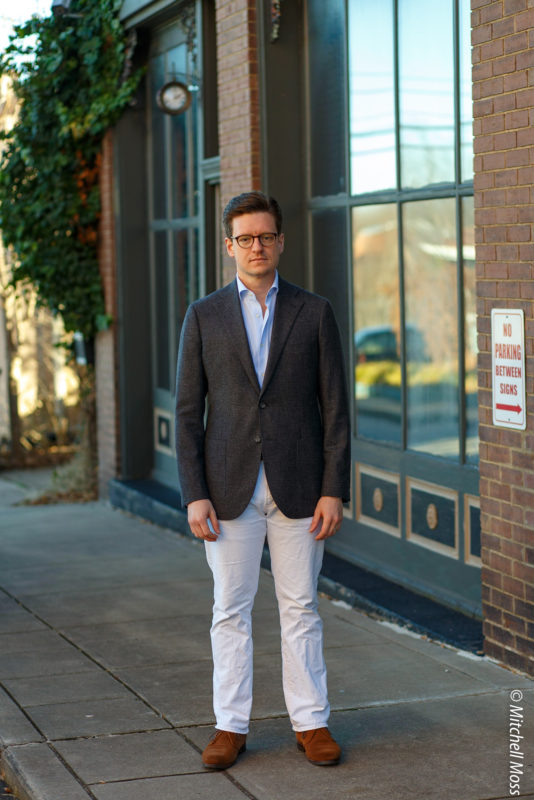


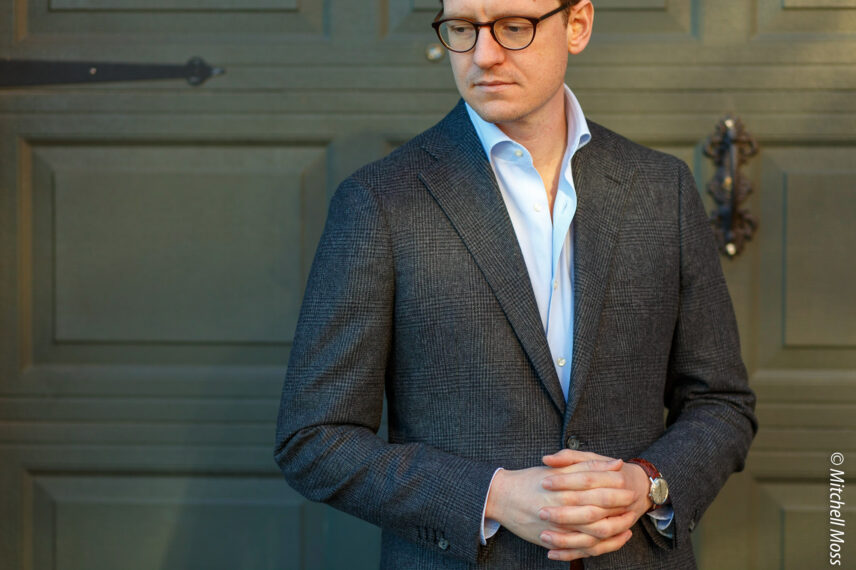
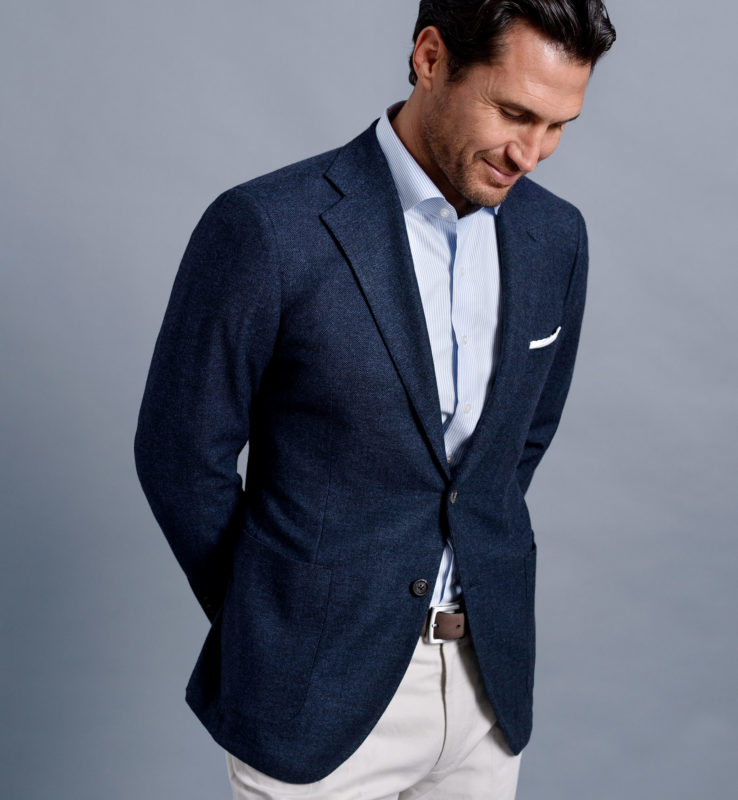
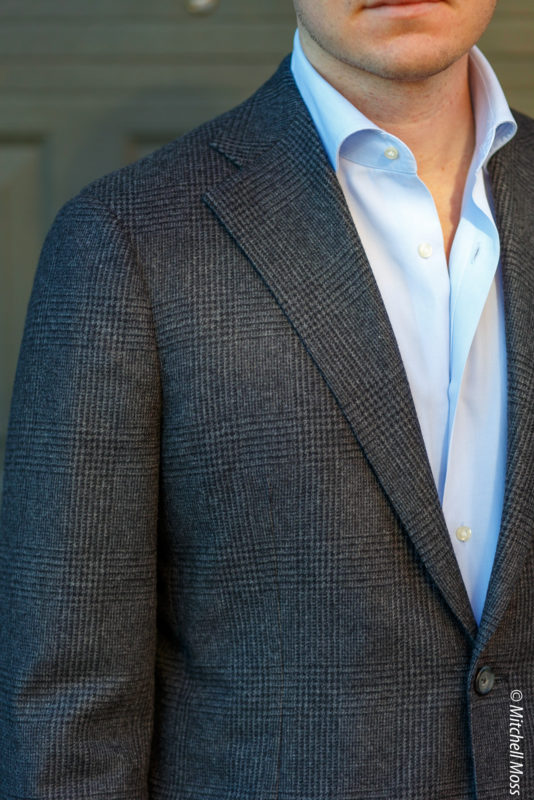
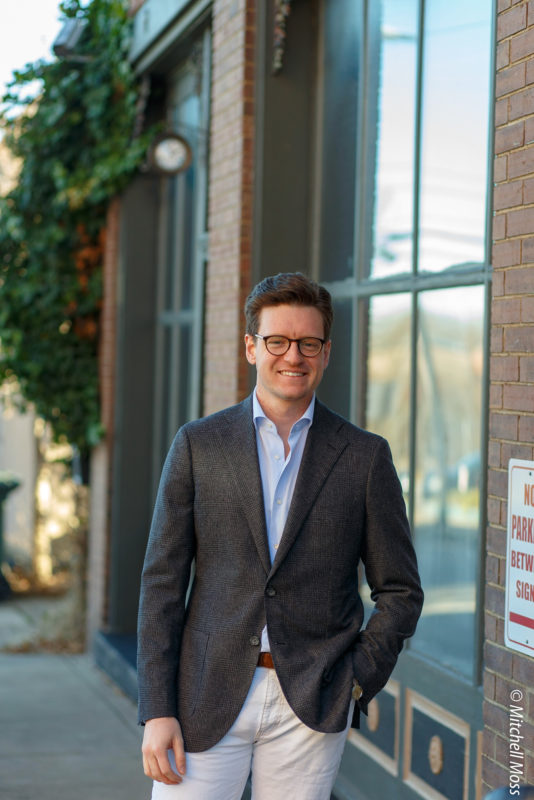
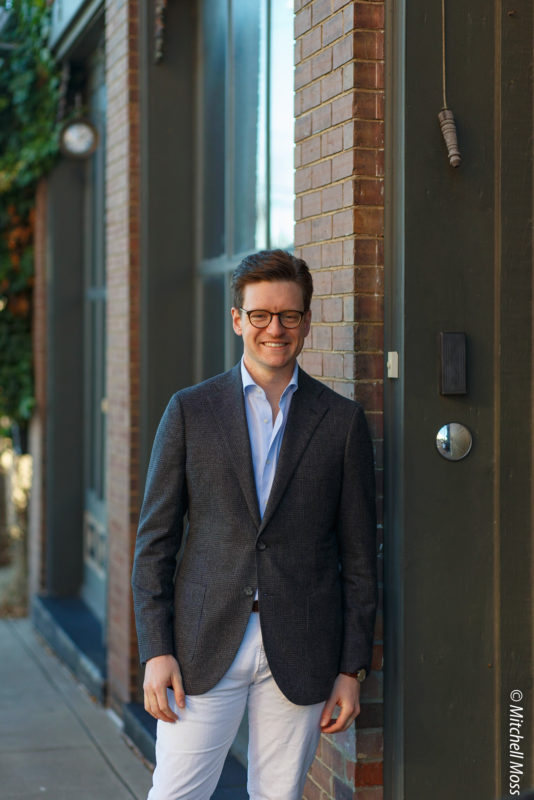
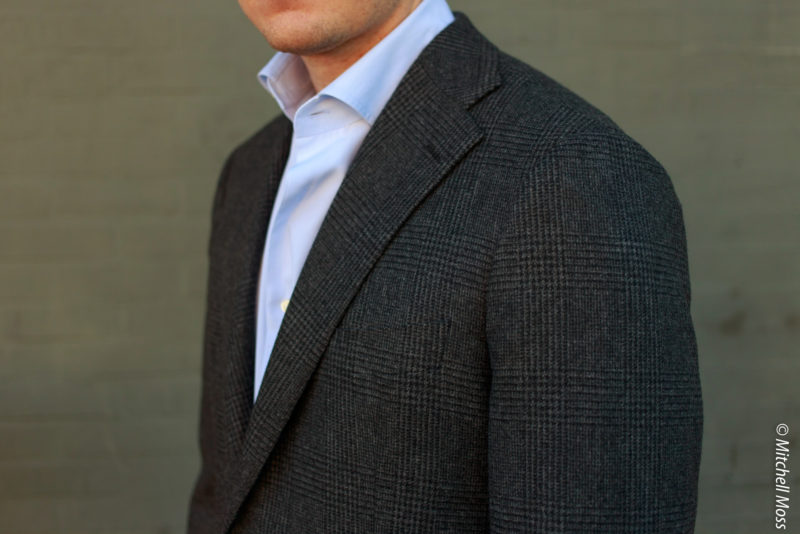
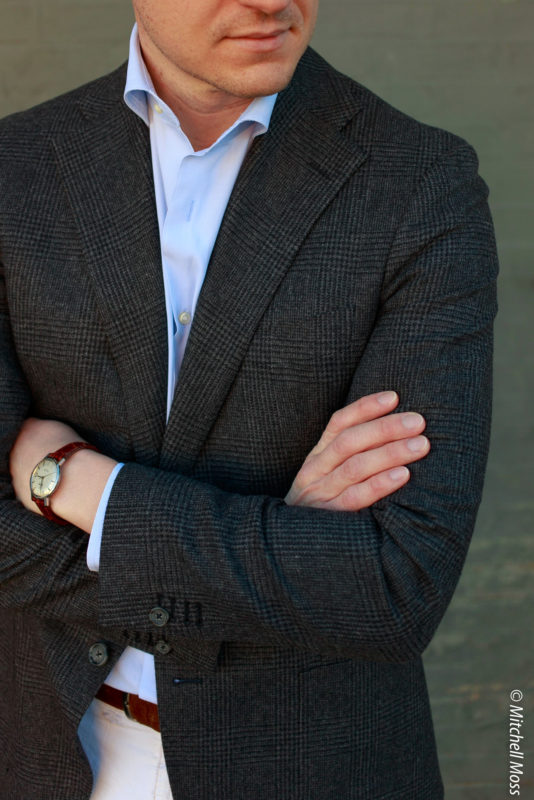
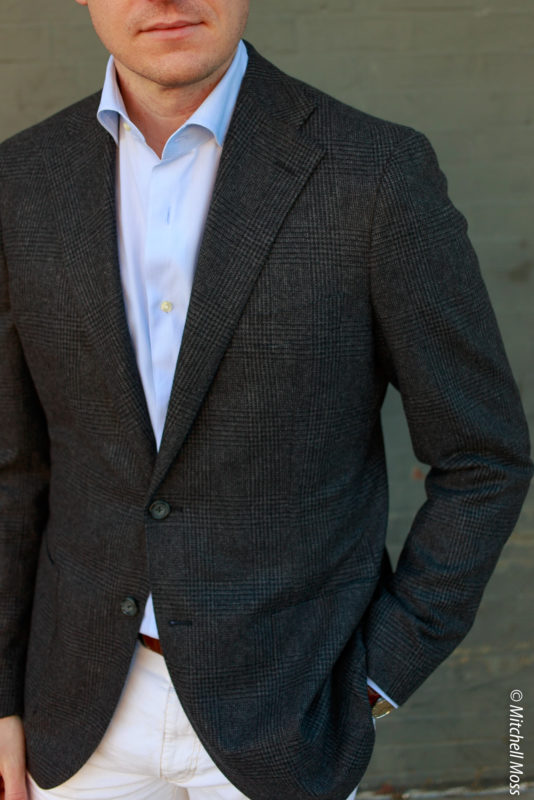
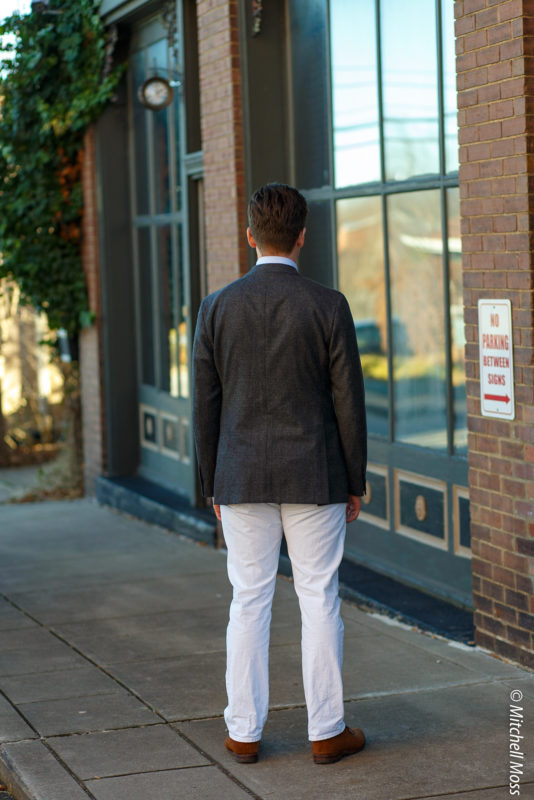
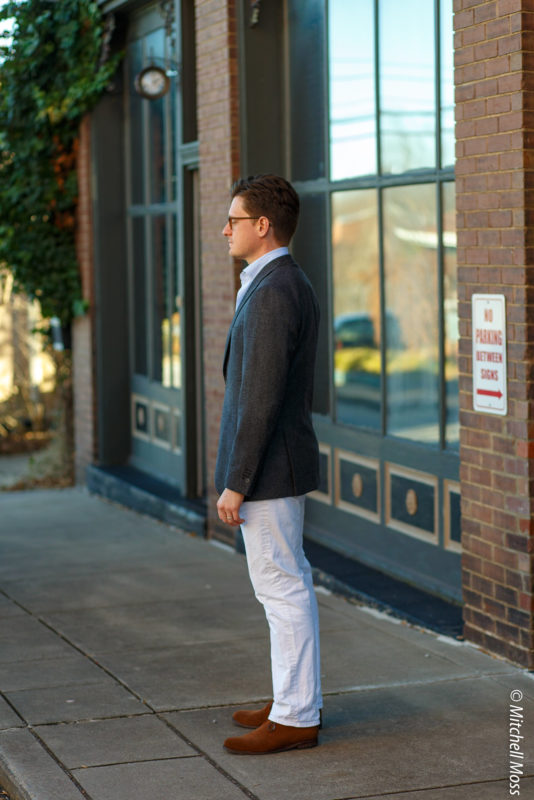
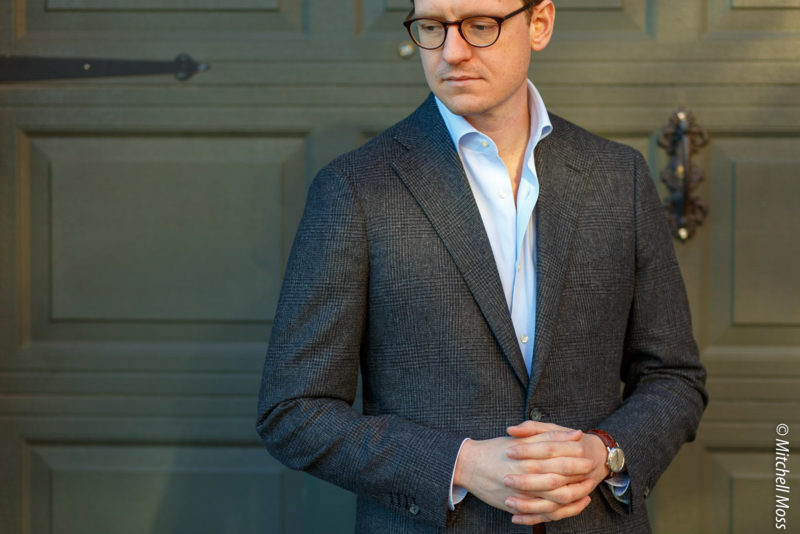

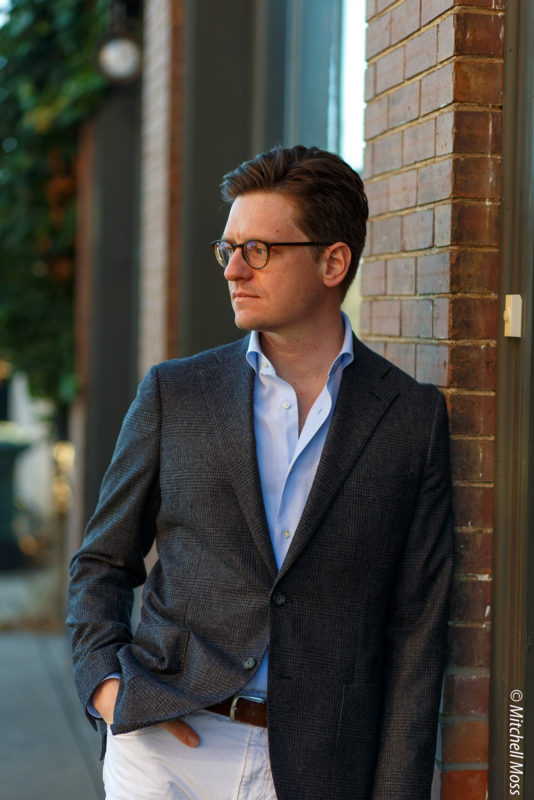
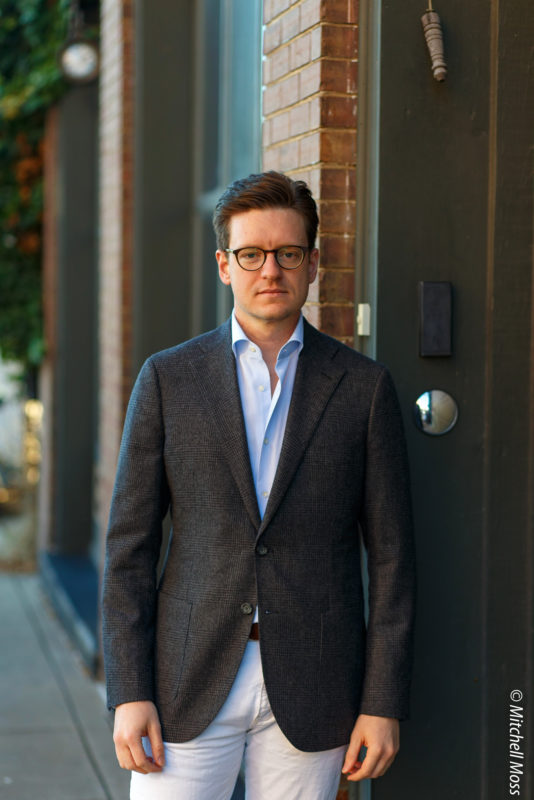
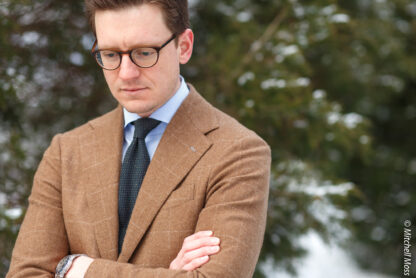
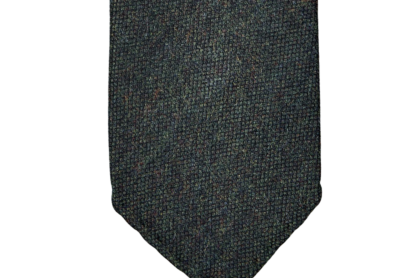
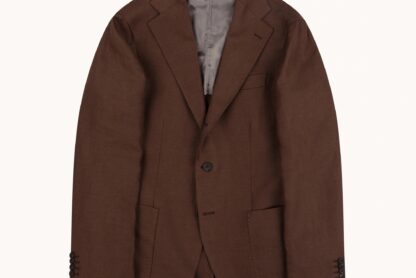

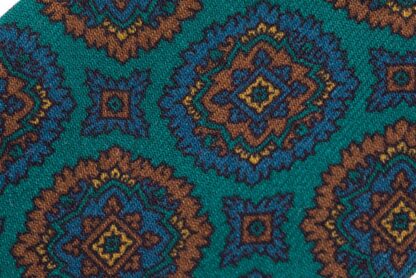
Is that a Proper Cloth shirt you’re wearing in this picture? If so, can you specify the collar, fabric, etc? I need something for a wedding, looking for a good fabric to go with a soft roma cutaway collar. Will be wearing a blazer with slacks and a tie. Oxford seems a bit too casual, but the shirt you have here seems pretty spot on. Thanks!
It isn’t a Proper Cloth shirt. However, my go-to collar style of theirs is the Soft Roma Cutaway (as you mentioned). The shirt I’m wearing is an end-on-end, which I like as a dressy option that can dress down easily, too.
The Stanton is probably nice: https://propercloth.com/fabrics/stanton-120s-sky-blue-end-on-end-1877.html
or their lower priced Miles: https://propercloth.com/fabrics/miles-120s-light-blue-end-on-end-2096.html
I have no experience with either, but reviews seem positive.
I’d go with no front placket, soft button cuffs, single yoke, side pleats.
Thanks for this, really a big help. Continue to share your unique ideas. https://bit.ly/3si1Uzb